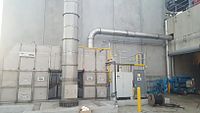
Photo from wikipedia
Abstract The thermoelectric modules have the bidirectional characteristic, which can work either in power generation mode based on Seebeck effect or in heating-cooling mode based on Peltier effect. In this… Click to show full abstract
Abstract The thermoelectric modules have the bidirectional characteristic, which can work either in power generation mode based on Seebeck effect or in heating-cooling mode based on Peltier effect. In this paper, a feasibility study is performed for a bifunctional thermoelectric generator applied in vehicle engines, which can use Seebeck effect for waste heat recovery and Peltier effect for engine warm-up. To predict the bidirectional behaviours of the thermoelectric module, a dual-mode thermoelectric module model is developed, and the simulation results for the two modes (power generation mode and heating-cooling mode) are both verified with experiments. The four-quadrant operation diagram of thermoelectric module, which clearly presents the cooling, heating and power generation curves, is produced based on the validated model. A case study of applying a bifunctional thermoelectric generator to a 2 l-diesel engine passenger car is then carried out based on a further extended bifunctional TEG model and an engine oil and coolant circuit model. The simulation results shows that the optimal engine oil temperature (100 °C) cannot be reached in the new European driving cycle for the baseline engine without thermoelectric generator, but it can be reached by both applying thermoelectric generator operating in waste heat recovery mode and engine warm-up mode. Compared with the thermoelectric generator only operating in waste heat recovery mode, a 3-min faster warm-up effect of engine oil can be obtained when the bifunctional thermoelectric generator works in engine warm-up mode with electrical current applied. It also finds out that the electric power generated in waste heat recovery mode at vehicle starting and low vehicle speed phrase is limited. However, a faster warm-up effect (engine oil temperature rising 7 °C in the first 100 s) can be obtained by operating thermoelectric generator in engine warm-up mode at vehicle staring. The electric energy used in engine warm-up mode can be regenerated in the later waste heat recovery mode. To compensate all the used electric energy in engine warm-up mode, longer time of thermoelectric generator operating in waste heat recovery mode is needed.
Journal Title: Applied Energy
Year Published: 2019
Link to full text (if available)
Share on Social Media: Sign Up to like & get
recommendations!